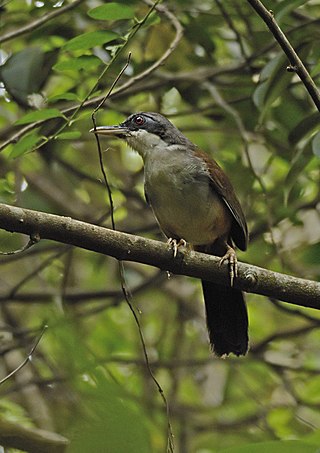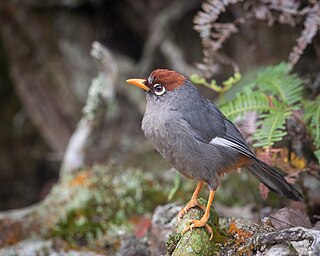
Garrulax is a genus of passerine birds in the laughingthrush family Leiothrichidae.

The ashy-headed laughingthrush is a member of the family Leiothrichidae. The laughingthrushes are a large family of Old World passerine birds characterised by soft fluffy plumage. These are birds of tropical areas, with the greatest variety in southeast Asia.

The white-crested laughingthrush is a member of the family Leiothrichidae. It is a highly social and vocal bird found in forest and scrub from the Himalayan foothills to Southeast Asia.

The Northeast India-Myanmar pine forests is a montane subtropical coniferous forest ecoregion in the mountains of Northeastern India and adjacent portions of Myanmar.

The white-throated laughingthrush is a species of passerine bird in the family Leiothrichidae. It is found mainly in the northern regions of the Indian subcontinent, primarily the Himalayas, and some adjoining and disjunct areas. It ranges across Afghanistan, Bhutan, India, Myanmar, Nepal, Tibet and Vietnam. Its natural habitat is subtropical or tropical moist montane forests.

The black-throated laughingthrush is a species of bird in the family Leiothrichidae. It is found in Cambodia, China, Laos, Myanmar, Thailand, and Vietnam. It occurs as an introduced species in Hong Kong. Based on a combination of strong morphological and genetic evidence, the subspecies on Hainan Island is treated as a distinct species by some authors, Swinhoe's laughingthrush.

The moustached laughingthrush is a species of passerine bird in the family Leiothrichidae. It is found in China, India, and Myanmar where its natural habitat is subtropical or tropical moist montane forests.

The Wayanad laughingthrush is a species of laughingthrush in the family Leiothrichidae. It is endemic to the Western Ghats south of Goa in India. These laughingthrushes move in groups in dense forests, producing loud calls but tend to be hard to spot in the undergrowth. They have brown upperparts, a white throat, a broad black mask through the eye and a heavy bill with pale yellow on the lower mandible. Despite the name, derived from the Wayanad region, this species has a wider range than the four other south Indian species of laughingthrush that are restricted to the higher elevation hills.

The rufous-vented laughingthrush is a species of bird in the family Leiothrichidae. It is found in Bangladesh, Bhutan, India, Laos, Myanmar, and Vietnam. Its natural habitats are subtropical or tropical moist lowland forest and subtropical or tropical moist montane forest.

The chestnut-eared laughingthrush is a species of bird in the family Leiothrichidae. It is found in Vietnam and possibly Laos.

The barred laughingthrush is a passerine bird in the family Leiothrichidae. It is endemic to central China where its natural habitat is temperate forests.

The giant laughingthrush is a bird species in the family Leiothrichidae. It is found in central China and far northern India and Myanmar. Its natural habitat is temperate forests.
The chestnut-backed laughingthrush is a species of bird in the family Leiothrichidae. It is found in Northeast India and northern Myanmar. This species inhabits secondary growth, thickets, tall grasslands with scattered shrubs or dense bushes in stony scrub-covered ravines and hills, from the lowlands up to around 900 metres (3,000 ft). It is threatened by habitat loss.

The spotted laughingthrush is a bird species in the family Leiothrichidae. It is found in Bhutan, China, India, Myanmar, and Nepal. Its natural habitat is subtropical or tropical moist montane forests.

The rufous-necked laughingthrush is a bird species in the laughingthrush family, Leiothrichidae. It is found in Bangladesh, Bhutan, China, India, Myanmar and Nepal, where its natural habitats are subtropical or tropical moist lowland forest and subtropical or tropical moist montane forest. Little study was done on this species due to its abundance and lack of interest in its conservation.

The snowy-cheeked laughingthrush, also known as Sukatschev's laughingthrush, is a species of bird in the family Leiothrichidae. It is endemic to northern China where its natural habitat is temperate forests. It is threatened by habitat loss.

The rufous-crowned laughingthrush is a species of bird in the family Leiothrichidae. It is endemic to Taiwan. It was previously considered conspecific with the white-throated laughingthrush, P. albogularis.

The buffy laughingthrush, also known as the chestnut-winged laughingthrush is a species of bird in the family Leiothrichidae. It is found in the Chinese mainland. It was formerly considered a subspecies of the rusty laughingthrush, P. poecilorhynchus; a species restricted to Taiwan following the split. Compared to the rusty laughingthrush, the buffy laughingthrush has paler grey underparts, more contrasting rufous wings, broader white tips to the tail, and distinct black lores.

Ianthocincla is a genus of passerine birds in the family Leiothrichidae.

Pterorhinus is a genus of passerine birds in the laughingthrush family Leiothrichidae.





















